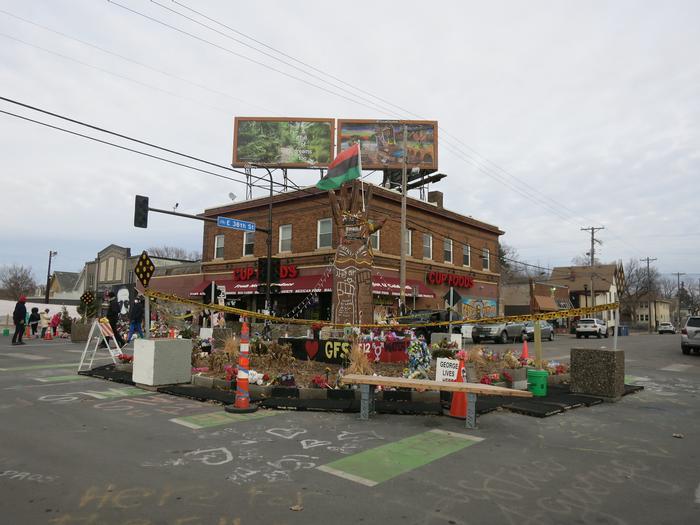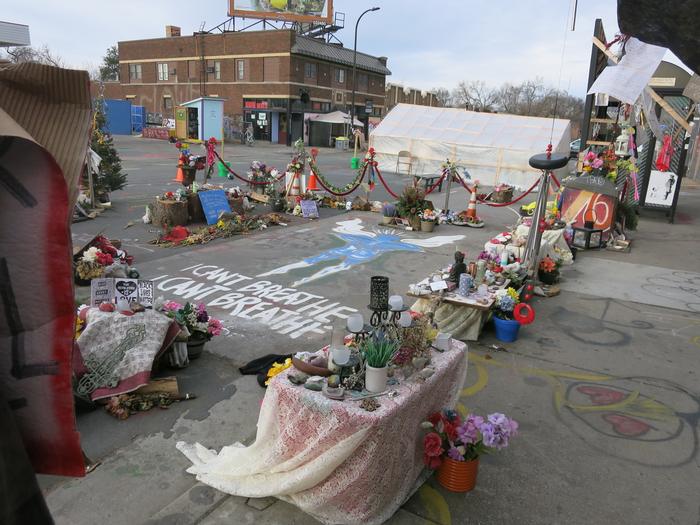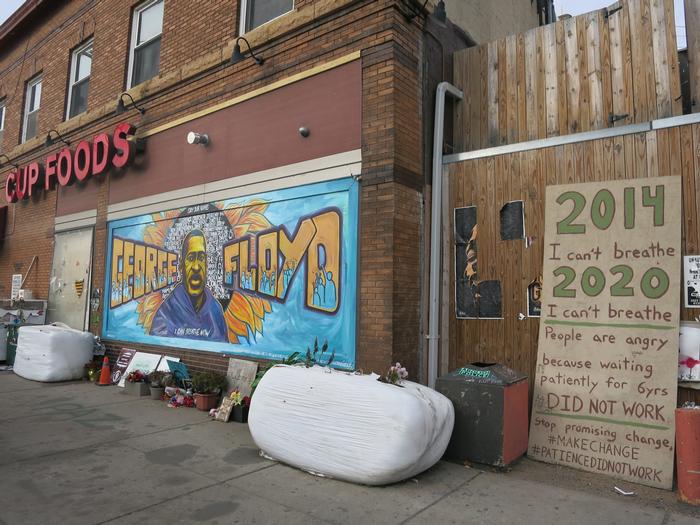[ID:4191] Prioritizing Preservation in MinneapolisUnited States As a future architect, what is the best way you can serve the needs of your local community?
George Perry Floyd Jr., a 46-year-old African-American man, was murdered by police officers on May 25th, 2020. The police were called when Floyd allegedly used a counterfeit twenty-dollar bill during a transaction at a grocery store. Derek Chauvin, a white police officer, knelt on the neck of George Floyd, choking off his oxygen supply for nine and a half minutes while three other police officers stood nearby. The location of this murder took place outside of the Cup Foods store at the corner of 38th and Chicago Streets in Minneapolis, Minnesota. The site has since been transformed into a place of hope, grief, and resistance. George Floyd's killing initiated worldwide advocacy for racial justice and opposition to police brutality, which aligns with the values of the Black Lives Matter movement that began in 2013. As of today, community members are able to visit the site which has been referred to as “George Floyd Square,” and it has been carefully tended to as a way of respecting the life of George Floyd and the Black Lives Matter movement.
George Floyd’s death was filmed and broadcasted around the world. The once residential and commercial intersection in the neighborhood of Minneapolis now serves as the epicenter for historic and social justice around the world. The site itself has taken on an ad hoc vernacular fashion as people have left artwork and flowers to establish a sense of place for mourning and remembrance. The activist-oriented impulses that have taken place at the Square must be memorialized in a way that is permanent in order for this nationwide expression of activism and change to be sustained. Character-defining features of the Square include a colorful mural that was painted on the exterior of the Cup Foods store, showing a portrait of George Floyd with the words “I can breathe now.” The mural also lists his name and those of many other Black people who died as a result of police brutality and racial prejudice. Outside of the Cup Foods entrance in the exact location where George Floyd died, his silhouette has been painted on the pavement in blue with angel wings. George Floyd’s words as the police officer knelt on his neck, “I can’t breathe” are written just below. Numerous other paintings now decorate the sidewalks, roadways, and buildings around the entire intersection with statements such as “George Lives Here,” “Justice for George Floyd,” and “Say His Name.” In the middle of the intersection is a large cardboard sculpture representing a fist. Caution tape circles the monument, blocking anyone from touching it. Flowers and smaller signs occupy the base of the fist sculpture. There is silence in the Square, which has to do with the absence of vehicles driving through the site since the roads leading up to the intersection have been closed off. This enables visitors to mourn respectfully and thoughtfully, and to look at all of the artwork around the Square.
When considering the role of artwork in the space, it is interesting to acknowledge what it communicates to the community it occupies. When an environment is occupied with something like a mural on a wall, it indicates that the space belongs to or adheres to the motivations of that thing, idea, or person. As artists become involved in the creation of a mural, they are articulating a relationship between themselves and the community for which they are creating. The same thing can be said about architects and the structures and designs they create. Though murals act as overt and explicit artwork, a building may seem like more of a space to traverse and may not encourage thoughtfulness from the audience in the way that artwork does. In short, few people may be consciously aware of how an environment and the structures upon it may shape their outlook of the world. In this case, because George Floyd Square occupies space, it creates a dialogue and teaches those who engage with that piece of land about what happened on May 25th, 2020 while encouraging activism and participation. Having a site and a permanent memorial attracts and makes possible the concept of people being able visit, remember, and learn.
Observing the Minneapolis City Council’s conversations about what to do with George Floyd Square demonstrates to me, as a future architect, how essential it is to be cognizant of the way structures are destroyed or remembered, and how preservation can have a significant impact by indicating what is of value to the built environment and society at large. The complex policy work that the City Council is responsible for managing could be aided from an architectural and preservation-based point of view that focuses on community inclusion since the built environment can foster education and healing in communities, and preservationists have the power to ensure this. In terms of dealing with the difficult question of who is in charge of placemaking at the site, the City Council can engage holistically with the site and use the tools of creative placemaking that requires input from community members. The Square is a site of community expression and inclusion, and should continue to be as choices are made regarding the Square going forward. As of now, the City Council has not yet made final decisions about the future of the Square and complicated questions continue to come to light. If the intersection at the Square were to be reopened, what would that signify to the community about the importance of the site? How can the site be functional and safe while remaining a space that memorializes the life of George Floyd? What role can historic preservationists have in ensuring the conservation and memorialization of George Floyd Square? Assessing the current conversation from an architectural standpoint, one that deals with synthesizing both politics and the operation of communities, could offer insight into how design or preservation decisions could be made that balance the goals of those who want to reopen the space with those who want to keep the Square as a closed-off, sacred site.
Conversations about reopening the Square to transportation and business operations have support from the City Council member of the Eighth Ward, which is the Ward that includes George Floyd Square. The idea of reopening has been raised in part due to an increased amount of crime taking place in the area. The conversations about potentially reopening the Square in a manner that still memorializes George Floyd continue through the deep involvement of the Minneapolis City Council and their acknowledgement of the concerns of community members. The City explains on their website that they have been involved with community members and state that they prioritize safety at the Square, supporting the functions of the Square, supporting racial justice, supporting the artists who have worked in the Square, and being open to establishing a memorial that will continue to honor George Floyd. As of today, the barricades still remain around the Square, separating the space as a realm of its own, dedicated to memorializing the life of George Floyd.
The City’s website provides updates regarding policies taking place at the site. One current topic of conversation addresses what will happen to the site since Minnesota is a state that experiences all four seasons with a particularly cold and snowy winter. How can the memorial be preserved through different seasons? The Minneapolis Public Works department is involved with the design and functions of infrastructure like road signs and bikeways throughout the city. They have also been put in charge of developing designs that are cognizant of maintaining the art and functions of George Floyd Square as well. They proposed two design options for wintertime regarding where exactly barricades would be placed and which street areas would be open to cars. The designation of Public Works to this assignment is interesting, especially when considering that a significant focus of Public Works is on circulation in the city, and their expertise doesn’t necessarily seem to include the tools that are required to make the careful and politically sensitive decisions that need to be made about the Square.
Though City Council members have the final say in what happens at the Square, the degree to which the community members have already shaped the space is profound. The City has responded to a handful of demands from the community, including altering their 2020 budget to distribute money to community participants and organizations involved in the Square, like Creative Citymaking, which deals with the power of art and community. Additionally, the City has declared 38th Street a Cultural District, and has begun the process of renaming the street “George Perry Floyd Jr. Place.” Conversations between crucial community members including Jeanelle Austin and Kia Bible with City Council members have made these things possible. Hundreds of volunteers have also worked to maintain the Square. This includes providing security, cleaning up trash and snow around the site, conducting clothing and book donations, and providing medical care. A greenhouse was even created for more than 300 plants that had been left at the memorial over time. There is also a group of about twenty people dedicated to preserving the abundant amount of art within the Square. The City’s website did not specify the ways in which they are or are not helping these individuals in their preservation efforts, but does note that these preservation efforts by individuals are being made. It is clear that the community has come together in a grassroots way to establish these services and has used the site to help those in need. Facilities like the medical team, the greenhouse, and donation sites are things that we typically do not think of as memorials. Therefore, we must consider how the site can be configured to both memorialize and continue to offer these valuable facilities.
Preservationists who are aware of the social implications of design might be able to navigate a situation like this, where City Council members are currently the ones making decisions about the future of important components of the built environment. While the City’s website outlines the ways in which they have communicated with community members, there is concern over the extent to which the City Council deserves to have the final authority in what happens to this incredibly meaningful and important site. City Council members may have a lens focused solely on the infrastructure operations surrounding the Square, while architects or preservationists may have a broader interest in discerning what the built environment conveys by recognizing the significance of place and what it says about history. Architects and preservationists might be better equipped to assess the ongoing conversations, which include design issues, space concerns, and recognizing who they impact. We depend on sensory experiences – vision, sound, touch – to understand space and its histories. Therefore, people are connected to specific places based on what is preserved within their communities. If components of the built environment are not protected, it is easy for people to cease to pay attention to the components of history around them, and that history is easier to forget and harder to learn from. The inclusion of preservationists, particularly non-white preservationists who recognize community needs, could foster the conversation and offer valuable insight into how preservation affects a community. If the site were to be reopened for business and transportation operations, emotions evoked at the site might be subdued and the ability to mourn would be quelled by cars passing by. This could communicate to the community that commercial activity at the site takes priority over memorializing George Floyd, and it might seem as though evoking emotion is avoided for the sake of efficiency. It becomes apparent that those who are given agency in what goes on in the built environment ultimately decide how people move, process emotion, and utilize space.
However, it is important to recognize the way in which the conversations about social justice must begin and continue to take place within the field of architecture and preservation as well. These professionals are responsible for listening to community members in order to create design that is meaningful, practical, and helpful to a broad community that might not have components of the built environment dedicated to honoring their experiences. The absence of the preservation of spaces belonging to marginalized communities may not be a conscious choice by preservationists, but it is a symptom of a much larger problem that is perpetuated and shapes the built environment, and has the power to include or exclude members of society. As mentioned before, preservationists could play a large role in deciding the physical form of the built environment, deciding how the city functions, and deciding what components of history should be celebrated or remembered. By looking at an annual report of a preservation commission in any city, one is able to gain an understanding of what architecture is significant to them and can gain a sense of what those preservationists choose to recognize along with what they find significance and value in preserving. The built environment can be viewed as a demonstration of the ideologies of architects and preservationists, so it is important to investigate how these people have the power to represent moments in history.
With that being said, the future of architecture is inspiring because strength and education can be provided to many and people are recognizing the ways that social justice can be made possible through the built environment. Everyone is entitled to their own opinions about the world they navigate and the structures they dwell within, so the field of architecture could offer insight regarding how to evaluate conflicts and differences that inevitably arise through a variety of opinions. The City of Minneapolis should consider including Black preservationists and architects in the conversation and process of designating the site where George Floyd was murdered to be a permanent landmark and memorial. This would ensure that the erasure of the site's significance doesn't happen and that the site will continue to function and be remembered in a way that future generations can learn from.
If you would like to contact this author, please send a request to info@berkeleyprize.org. |




